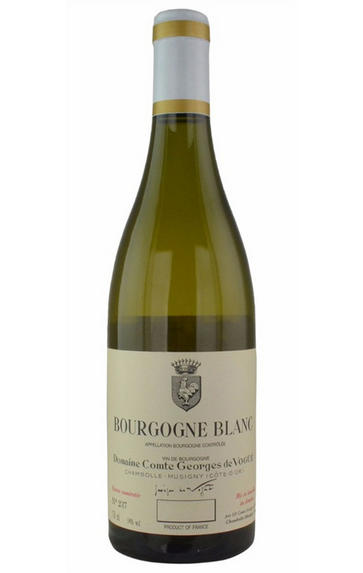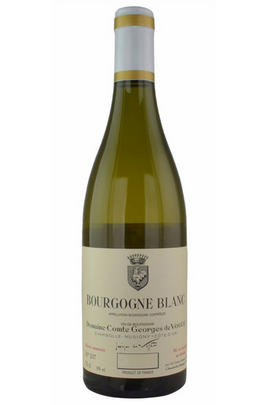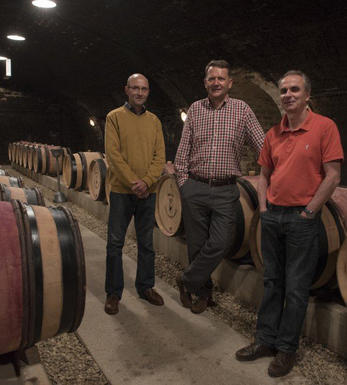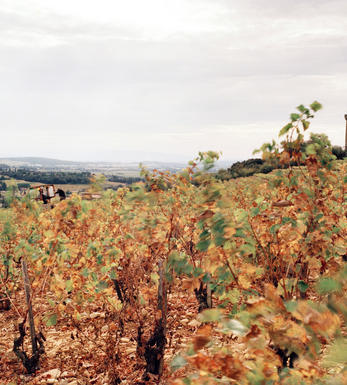
2007 Bourgogne Blanc, Domaine Comte Georges de Vogüé, Burgundy

Critics reviews
Allen Meadows - burghound.com - Jul 2012
About this WINE

De Vogue
The Domaine Comte de Vogüé in Burgundy dates back to 1450 when Jean Moisson constructed the original building. The property stayed in the same family, passing through the female line from time to time until a Catherine Bouhier married Cerice-Melchior de Vogüé in 1766. Somehow the family, though in exile in England, managed to retain control of the domaine during the French revolution. Modern history and the current label begin with Comte Georges de Vogüé who took over in 1925. The first heyday of the domaine came during the 1940s, 1950s and 1960s. The domaine owns 7.25 hectares of the fabled Le Musigny vineyard which constitutes 80% of the whole site. In addition, it has 2.75 hectares of Bonnes-Mares and 1.8 hectares of Premier Cru Chambolle-Musigny.
Under the aegis of estate manager Jean-Luc Pepin, with winemaker François Millet and the aptly named Eric Bourgogne in the vineyards, this domaine currently cannot put a foot wrong; it ranks amongst the very best Burgundy houses. Tastings at de Vogüé have become a perverse highlight of any buying trip - nobody is allowed to taste unless François is present. In his exemplary measured English François will distill the essence of each vintage in a mixture of metaphysical and anthropomorphic metaphors.
The average age of vines in Le Musigny is 40 years old and all is labelled as Vieilles Vignes. This is Red Burgundy at its sublime best - marvellously perfumed, rich, ripe fruit, perfectly balanced and exquisitely harmonious. The best wines will keep for up to 50 years.
The vineyards are run more or less organically by Eric Bourgogne and his team, though they do not claim organic status. There is a mix of guyot and cordon training, in either case pruned for low yields. In the cellar François Millet will adapt techniques to suit the year. He likes a cool pre-maceration since glycerol is enhanced during this phase. Thereafter the temperature during fermentation should not exceed 32-33ºc. The oak regime is light on new wood: typically 15% for the village Chambolle and 35% for the grands crus, occasionally a little more.
Jasper Morris MW, Burgundy Wine Director and author of the award-winning Inside Burgundy comprehensive handbook.

Bourgogne Blanc
Bourgogne Blanc is the appellation used to refer to generic white wines from Burgundy, a wide term which allows 384 separate villages to produce a white wine with the label ‘Bourgogne.’ As a result of this variety, Bourgogne Blanc is very hard to characterise with a single notable style, however the wines are usually dominated by the presence of Chardonnay, which is just about the only common factor between them. That being said, Chardonnay itself varies based on the environmental factors, so every bottle of Bourgogne Blanc will vary in some way from the next! Pinot Blanc and Pinot Gris are also permitted for use in Bourgogne Blanc under the regulations of the appellation.
As Bourgogne Blanc is very much an entry-level white wine for most regions in Burgundy, prices are usually very reasonable, and due to the terroir and climate of Burgundy, Bourgogne Blanc wines tend to have a strong acidity to them, combined with a vibrant and often fruity palate when compared with other whites from the New World, say, allowing fantastic matchmaking with many different kinds of food.

Chardonnay
Chardonnay is often seen as the king of white wine grapes and one of the most widely planted in the world It is suited to a wide variety of soils, though it excels in soils with a high limestone content as found in Champagne, Chablis, and the Côte D`Or.
Burgundy is Chardonnay's spiritual home and the best White Burgundies are dry, rich, honeyed wines with marvellous poise, elegance and balance. They are unquestionably the finest dry white wines in the world. Chardonnay plays a crucial role in the Champagne blend, providing structure and finesse, and is the sole grape in Blanc de Blancs.
It is quantitatively important in California and Australia, is widely planted in Chile and South Africa, and is the second most widely planted grape in New Zealand. In warm climates Chardonnay has a tendency to develop very high sugar levels during the final stages of ripening and this can occur at the expense of acidity. Late picking is a common problem and can result in blowsy and flabby wines that lack structure and definition.
Recently in the New World, we have seen a move towards more elegant, better- balanced and less oak-driven Chardonnays, and this is to be welcomed.


Buying options
Add to wishlist
Description
A pretty nose of primarily wet stone and white floral aromas introduces intense, mineral-driven and beautifully well-delineated flavors that culminate in a driving, bone dry and overtly austere finish that delivers excellent complexity. As it always is, this offers a peculiar taste profile that is unique in that it is not at all like the Côte de Beaune grands crus but rather like a cross between Corton-Charlemagne and a great Chablis. This is sufficiently austere that it will not be to everyone's taste but I quite like it. I would further note that the vines appear to be arriving at a sufficient age where the resulting wine is again of serious quality.
Allen Meadows - burghound.com - Jul 2012
wine at a glance
Delivery and quality guarantee